Forest Resource Quality and Human Activity Intensity Change and Spatial Autocorrelation Analysis in Yulin City, China
Abstract
:1. Introduction
2. Materials and Methods
2.1. Study Area
2.2. Data Acquisition and Preprocessing
2.3. Data Processing and Analysis
2.3.1. Indicator Selection
2.3.2. Range Standardization
2.3.3. Graded Assignment Method
2.3.4. Weight Calculation
- 1.
- Select a sample and indicator, defined as sample i and indicator j;
- 2.
- Normalize the indicators; heterogeneous indicators are homogenized to obtain Xij;
- 3.
- Calculate the proportion of indicators Yij:
- 4.
- Calculate the entropy value of indicator j:
- 5.
- In the equation, k = 1/ln(n) > 0 satisfies the condition of eij ≥ 0;
- 6.
- Calculate information entropy redundancy:
- 7.
- Calculate the weights of various indicators:
2.3.5. Index Evaluation Results
2.3.6. Spatial Autocorrelation Analysis
- (1)
- Global spatial autocorrelation analysis
- (2)
- Local spatial autocorrelation analysis
3. Results
3.1. Temporal and Spatial Changes in Forest Resource Quality
3.2. Temporal and Spatial Variation in Human Activity Intensity
3.3. Autocorrelation Analysis of Forest Resource Quality and Human Activity Intensity
4. Discussion
5. Conclusions
Author Contributions
Funding
Data Availability Statement
Acknowledgments
Conflicts of Interest
References
- Wei, X.X.; Liu, R.G.; Liu, Y. Forest Change in China: A Review. Chin. Geogr. Sci. 2023, 33, 489–502. [Google Scholar] [CrossRef]
- Jones, K.P.; Venter, O.; Fuller, R.A.; Allan, J.R.; Maxwell, S.L.; Negret, P.J.; Watson, J.E.M. One-third of global protected land is under intense human pressure. Science 2018, 360, 788–791. [Google Scholar] [CrossRef] [PubMed]
- Dong, Q.D.; Chen, C.N.; Li, Y.H.; Zhao, T.X.; Sun, Z.X.; Zhang, Z.; Zhu, L.Q. Assessing the Protection Effectiveness and Spillover/Leakage Effects of the National Nature Reserve Group of Funiu Mountain Area in Henan Province Based on the NPP and Human Disturbance Index. Biodivers. Sci. 2023, 31, 102–113. [Google Scholar] [CrossRef]
- Li, W.; Guo, W.Y.; Pasgaard, M.; Niu, Z.; Wang, L.; Chen, F.; Qin, Y.C.; Svenning, J. Human fingerprint on structural density of forests globally. Nat. Sustain. 2023, 6, 368–379. [Google Scholar] [CrossRef]
- Mauro, A.; Francesco, P.; Martina, V.; Antonio, S. Cultural values and forest dynamics: The Italian forests in the last 150 years. Forest Ecol. Manag. 2022, 503, 119655. [Google Scholar] [CrossRef]
- McMichael, C.N.H. Ecological legacies of past human activities in Amazonian forests. New Phytol. 2020, 229, 2492–2496. [Google Scholar] [CrossRef] [PubMed]
- Zhang, G.G.; Hui, G.Y. Comprehensive Evaluation Method of Forest Quality Based on the Accumulation and Homogeneity. Sci. Silv. Sin. 2021, 57, 77–84. [Google Scholar] [CrossRef]
- Fernando, M.; Roberto, M. Evaluating the quality of riparian forest vegetation: The Riparian Forest Evaluation (RFV) index. Forest Sys. 2014, 23, 259–272. [Google Scholar] [CrossRef]
- Wu, G.J.; Zhao, T.Z. Study on the Forest resources quality evaluation based on BP neural network. In Proceedings of the 2010 Third International Conference on Information and Computing, Wuxi, China, 4–6 June 2010; IEEE: New York, NY, USA, 2010. [Google Scholar] [CrossRef]
- Cao, L.J.; He, X.B.; Chen, S.; Fang, L.M. Assessing Forest Quality through Forest Growth Potential, an Index Based on Improved CatBoost Machine Learning. Sustainability 2023, 15, 8888. [Google Scholar] [CrossRef]
- Rachana, P.; Vinay, V.; Manju, A. Impact of human activities on forest resources and wildlife population. Comput. Ecol. Softw. 2021, 11, 83–99. [Google Scholar]
- Wende, Z.M.; Hou, G.L.; Chen, H.M.; Jin, S.M.; Zhuoma, L.C. Dynamic changes in forest cover and human activities during the Holocene on the northeast Tibetan plateau. Front Earth Sci. 2023, 11, 1128824. [Google Scholar] [CrossRef]
- Du, W.W.; Hu, Y.; Sui, M.; Yuan, C. Study on Response of Temporal and Spatial Changes of Human Activity Intensity and Landscape Pattern in Jinfo Mountain National Scenic Area. Landsc. Archit. Acad. J. 2022, 39, 28–37. [Google Scholar]
- Yuan, H.W.; Cai, J.; Zhang, L. Temporal and Spatial Changes of Human Activities and Habitat Quality in National Key Ecological Function Areas and Their Spatial Effects. Arid Land Geo. 2023, 46, 934–948. [Google Scholar]
- Gong, Z.W.; Yao, S.B.; Gu, L. Spatial Relationship and Regional Structure Analysis for the Forest Resources Growth Rate in China. For. Econ. 2015, 37, 16–20. [Google Scholar] [CrossRef]
- Jing, T.Z.; Li, T.Y. Spatial Patterns of Forest Insect Outbreaks: A Review. Acta Ecol. Sin. 2018, 38, 3414–3421. [Google Scholar] [CrossRef]
- Zeng, C.Y.; Cheng, L.H.; Mi, X.Y.; Tan, Y.B.; Xu, Q.L.; Feng, J.Q.; Hu, J. Spatial Variation of Forest Carbon Density in Mao’er Mountain, Guangxi. J. Cent. South Univ. For. Technol. 2023, 43, 91–98. [Google Scholar] [CrossRef]
- Liu, Y.; Zhao, J.; Zheng, X.; Ou, X.; Zhang, Y.; Li, J. Evaluation of Biodiversity Maintenance Capacity in Forest Landscapes: A Case Study in Beijing, China. Land 2023, 12, 1293. [Google Scholar] [CrossRef]
- Yang, P.; Zhang, X.; Hua, L. Analysis of Urban Ecological Quality Spatial Patterns and Influencing Factors Based on Remote Sensing Ecological Indices and Multi-Scale Geographically Weighted Regression. Sustainability 2023, 15, 7216. [Google Scholar] [CrossRef]
- Xu, L.X.; Li, Z.Z. Present Situation and Countermeasures of Improving the Quality and Efficiency of Forest Resources in Yulin City. Mod. Agric. Sci. Technol. 2021, 21, 156–157+159. [Google Scholar] [CrossRef]
- Guo, N.; Xing, S.H.; Ji, W.; Cui, G.F.; Ze, L.G.; Wang, M.; Xue, Q.; Jiang, X.M. A Method for Forest Resources Quality Evaluation and its Application in Miyaluo Forest Regions, Western Sichuan. Acta Ecol. Sin. 2010, 30, 3784–3791. [Google Scholar]
- Mo, K. The Study on Quality Assessment Indicator System of Timber Forest and Its Methods at Subcompartment Level. Ph.D. Thesis, Beijing Forestry University, Beijing, China, 2015. [Google Scholar]
- Tian, Y.W.; Huang, Z.L.; Xiao, W.F.; Zeng, L.Y.; Xiang, Y. Assessment on Forest Ecosystem Health of Lanlingxi Watershed Based on Matter-element Model and Subcompartment Scale. Chin. J. Ecol. 2017, 36, 1458–1464. [Google Scholar] [CrossRef]
- Liu, L.J.; Xie, Z.H.; Lei, M.; Shi, Y.M.; Li, S.Q.; Liu, P. Evaluation of Forest Quality Based on Analytic Hierarchy Process—A Case Study in Liuxihe Forest Farm, Guangzhou. For. Resour. Manag. 2022, 6, 89–94. [Google Scholar] [CrossRef]
- Mei, H.; She, C.Y.; Lu, X. Study on the Quality Assessment Index Selection of Ecological Public-welfare Forests Based on Subcompartment Scale. J. Cent. South Univ. For. Technol. 2019, 39, 14–22. [Google Scholar] [CrossRef]
- Zhang, B.; Wang, Z.L.; Lei, F.J. Quality Evaluation of Forest Resources Based on Analytic Hierarchy Process and Matter Element Analysis—A Case Study of Yanchuan County. J. Northwest For. Univ. 2022, 37, 208–215. [Google Scholar] [CrossRef]
- Hu, Z.B.; He, Y.X.; Li, Y.H.; Zhu, J.J.; Li, X.Y. Landscape pattern change in Minjiang River upper reach under effects of anthropogenic activities. Chin. J. Ecol. 2007, 26, 700–705. [Google Scholar]
- Wu, M.Q.; Hu, M.M.; Wang, T.; Fan, C.; Xia, B.C. Recognition of Urban Ecological Source Area Based on Ecological Security Pattern and Multi-scale Landscape Connectivity. Acta Ecol. Sin. 2019, 39, 4720–4731. [Google Scholar] [CrossRef]
- Wang, J.Z.; Zhang, G.H.; Nie, Z.L.; Yan, M.J. Quantintative Assessment of Human Activity Intensity in Hutuohe Catchment. J. Arid Land Resour. Environ. 2009, 23, 41–44. [Google Scholar]
- Bao, Y.L.; Tian, B.; Hu, Y.C.; Zhang, W.J.; Wang, C.X.; Wang, T.Y. Numerical Simulation of PM2.5 in Beijing-Tianjin-Hebei Region Based on Mixed Effect Model. Environ. Pollut. Control 2020, 42, 268–274. [Google Scholar] [CrossRef]
- Ma, Z.F.; Yin, S.G.; Zhang, Y.; Li, Z.J.; Wu, Q.Y. Spatial Distribution, Flowing Rules and Forming Mechanism of Inter-Cities Floating Population in China. Geogr. Res. 2019, 38, 926–936. [Google Scholar] [CrossRef]
- Yang, P.S.; Chen, C.H.; She, J.Y. Evaluation of Forest Naturalness of Paiya Mountain State-owned Forest Farm, Jingzhou Miao in Dong Autonomous County. J. Cent. South Univ. For. Technol. 2022, 42, 19–32. [Google Scholar] [CrossRef]
- Su, H.; Jiang, Z.; Yang, J. Differential Basis of Payment for Ecosystem Services of Forest Park. J. Northeast For. Univ. 2022, 50, 117–123. [Google Scholar] [CrossRef]
- Chen, Y. Research on the Effect of Forest Protection in Khan Ma National Nature Reserve of Daxing’anling Mountains of Inner Mongolia. Ph.D. Thesis, Beijing Forestry University, Beijing, China, 2014. [Google Scholar]
- Peng, Y.; Tian, X.L.; Zhang, X.P.; Teliewuhan, K.; Chen, X.; Wang, X.J.; Xu, L. Preliminary Estimation of Forest Quality in Xinjiang Based on Continuous Forest Resource Data. J. Nanjing For. Univ. Nat. Sci. Ed. 2019, 45, 96–102. [Google Scholar] [CrossRef]
- Wu, C.; Jiang, A.D.; Zheng, W. Study on the Measures for Optimizing China’s Provincial Territorial Space Based on the Perspective of Resource and Environmental Carrying Capacity in the New Situation. Sustainability 2022, 14, 13754. [Google Scholar] [CrossRef]
- Ji, Y.F.; Jia, L.J.; Yang, L.A.; Li, Y.L.; Dong, Q.H. Spatio-temporal Evolution and Prediction Analysis of Habitat Quality in Yulin City Coupled with InVEST-PLUS Model. J. Soil Water Conserv. 2023, 37, 123–132. [Google Scholar] [CrossRef]
- Yin, Q.D.; Liu, C.X.; Tian, Y. Spatio-Temporal Greenness and Anthropogenic Analysis in Shaanxi Based on MODIS NDVI from 2001 to 2018. Acta Ecol. Sin. 2021, 41, 1571–1582. [Google Scholar] [CrossRef]
- Jing, B.; Li, T.X.; Wen, B.Q.; Cheng, W.H. Population-Economy Spatial Pattern and Impact Mechanism of the Qinba Mountain Area Based on Topographic Factors. Sci. Geogr. Sin. 2020, 40, 793–803. [Google Scholar] [CrossRef]
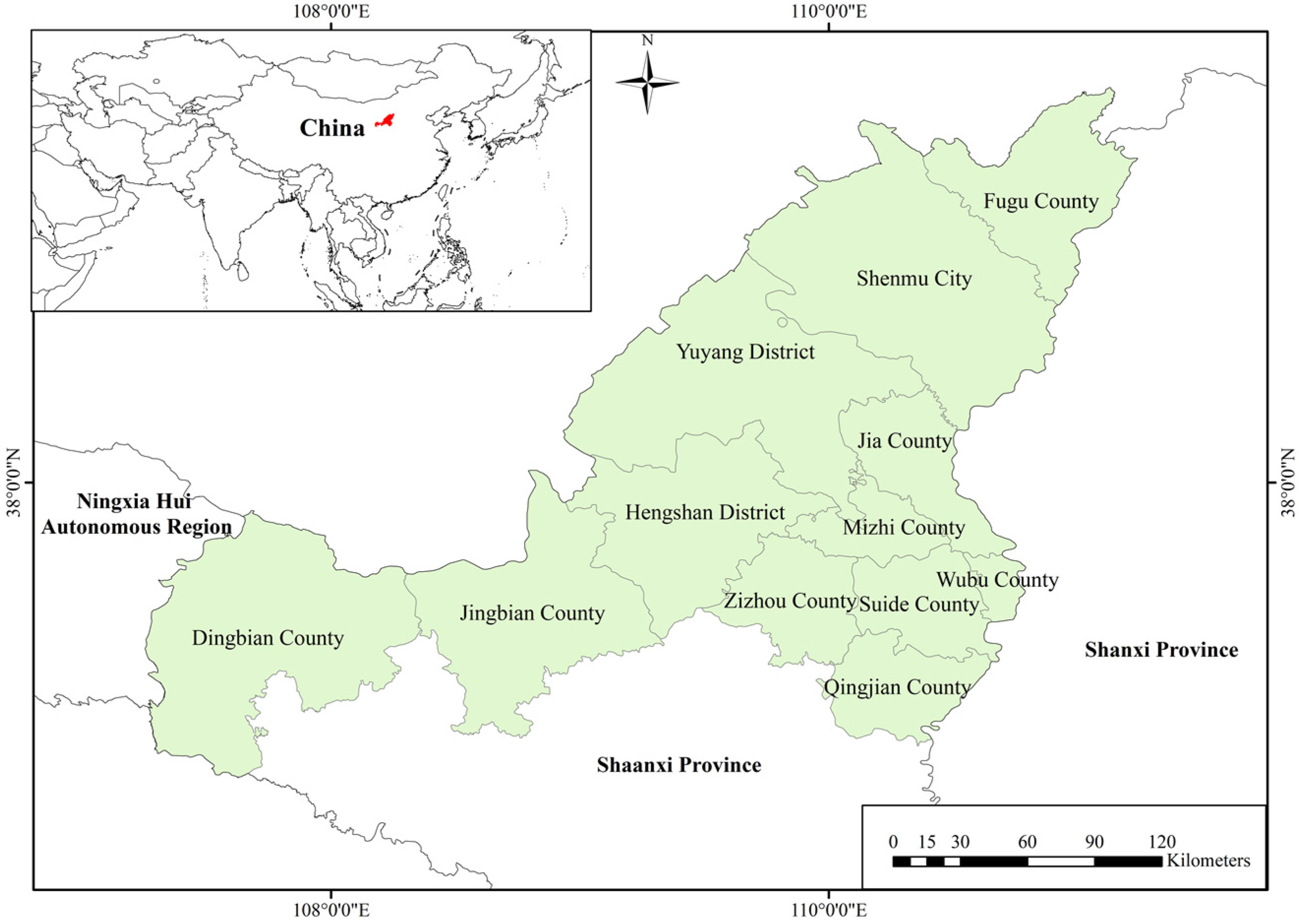
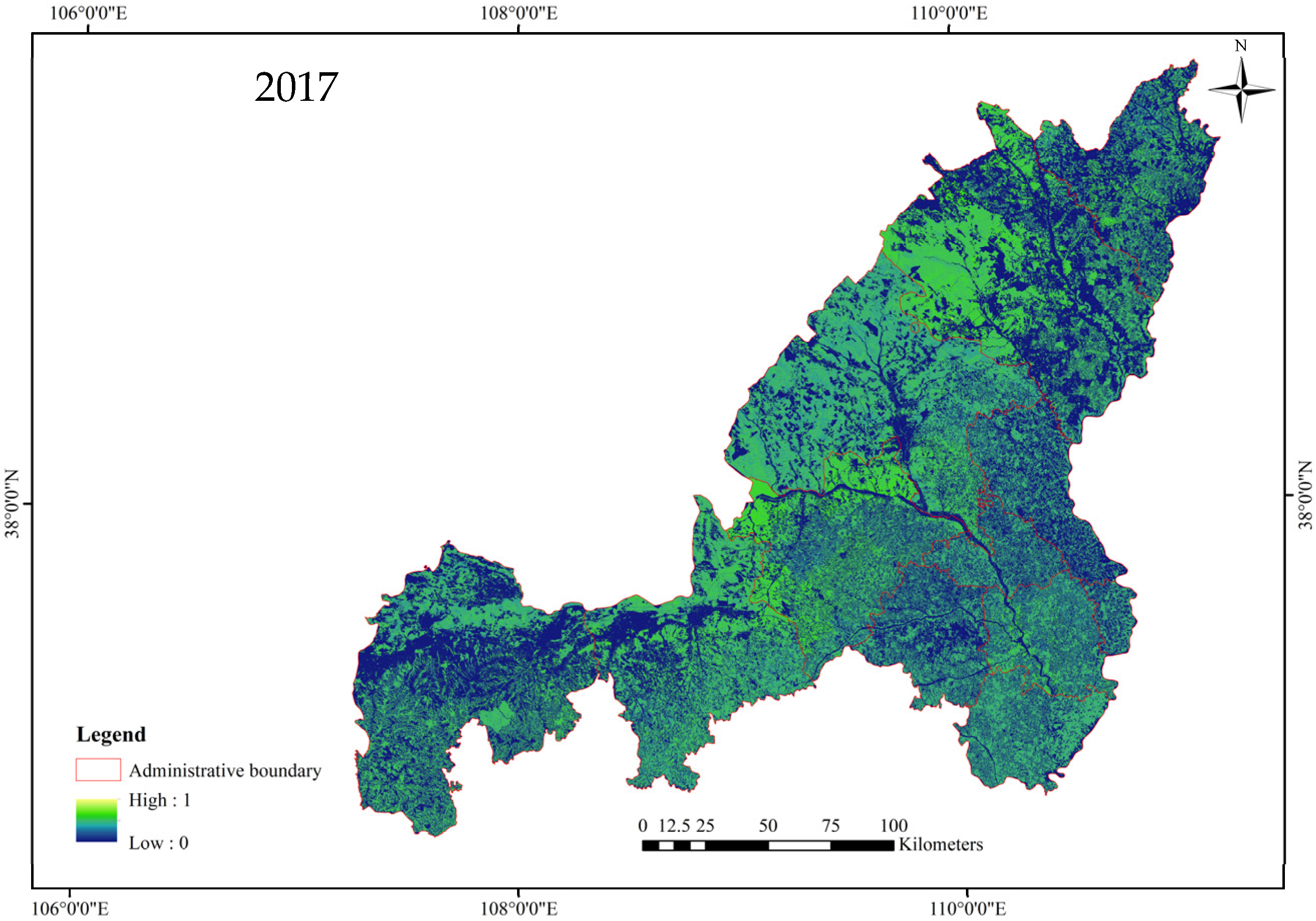
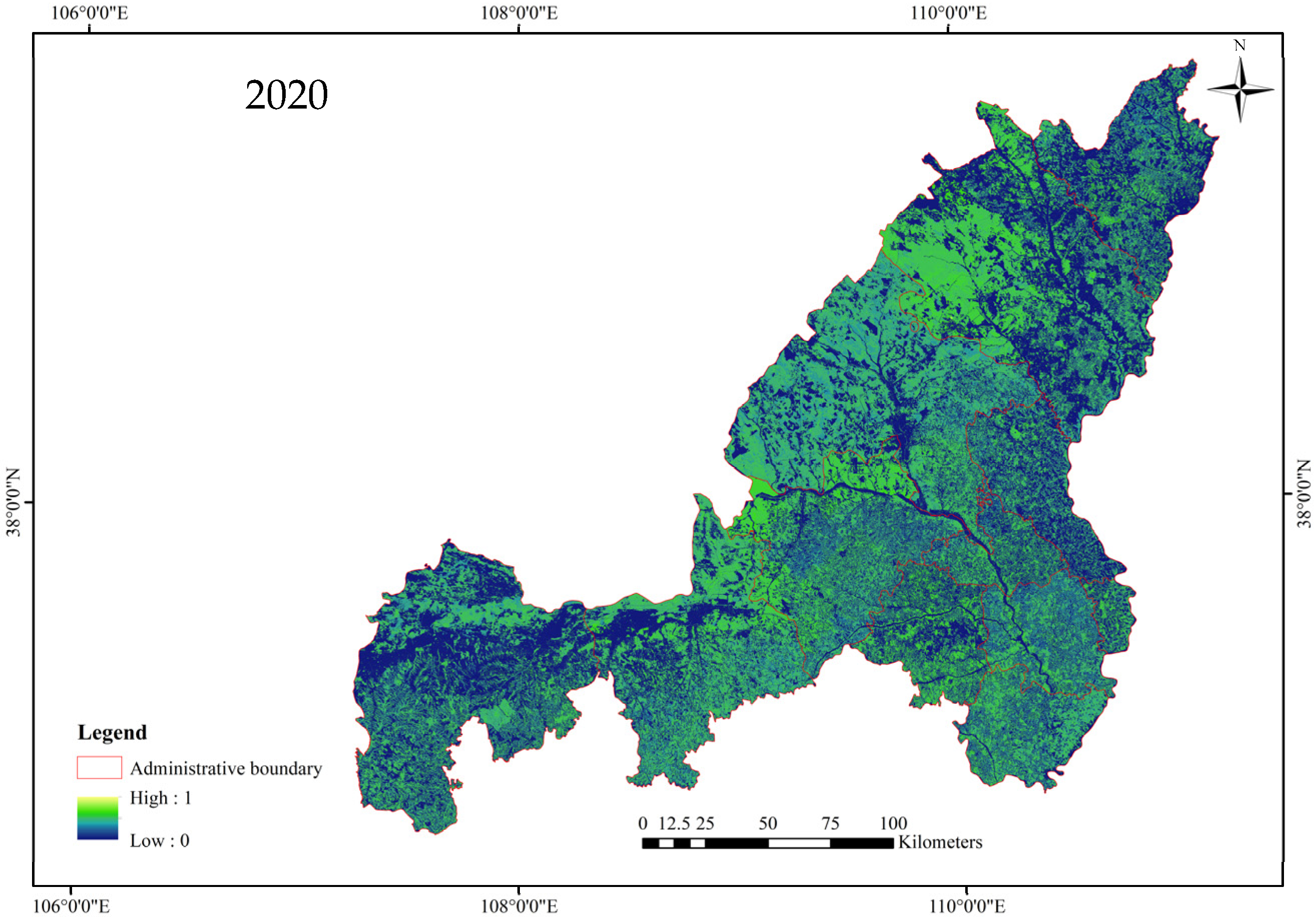
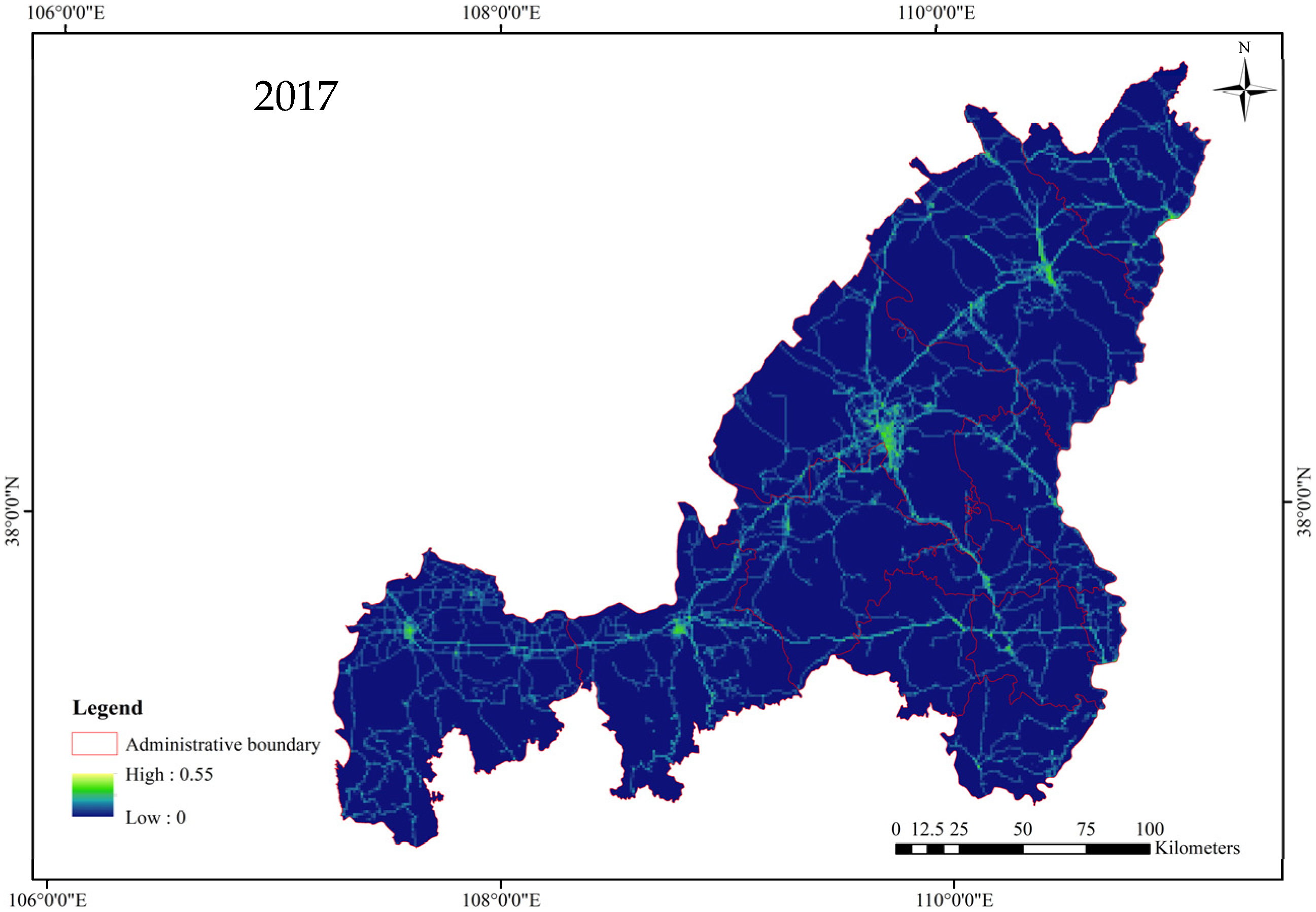

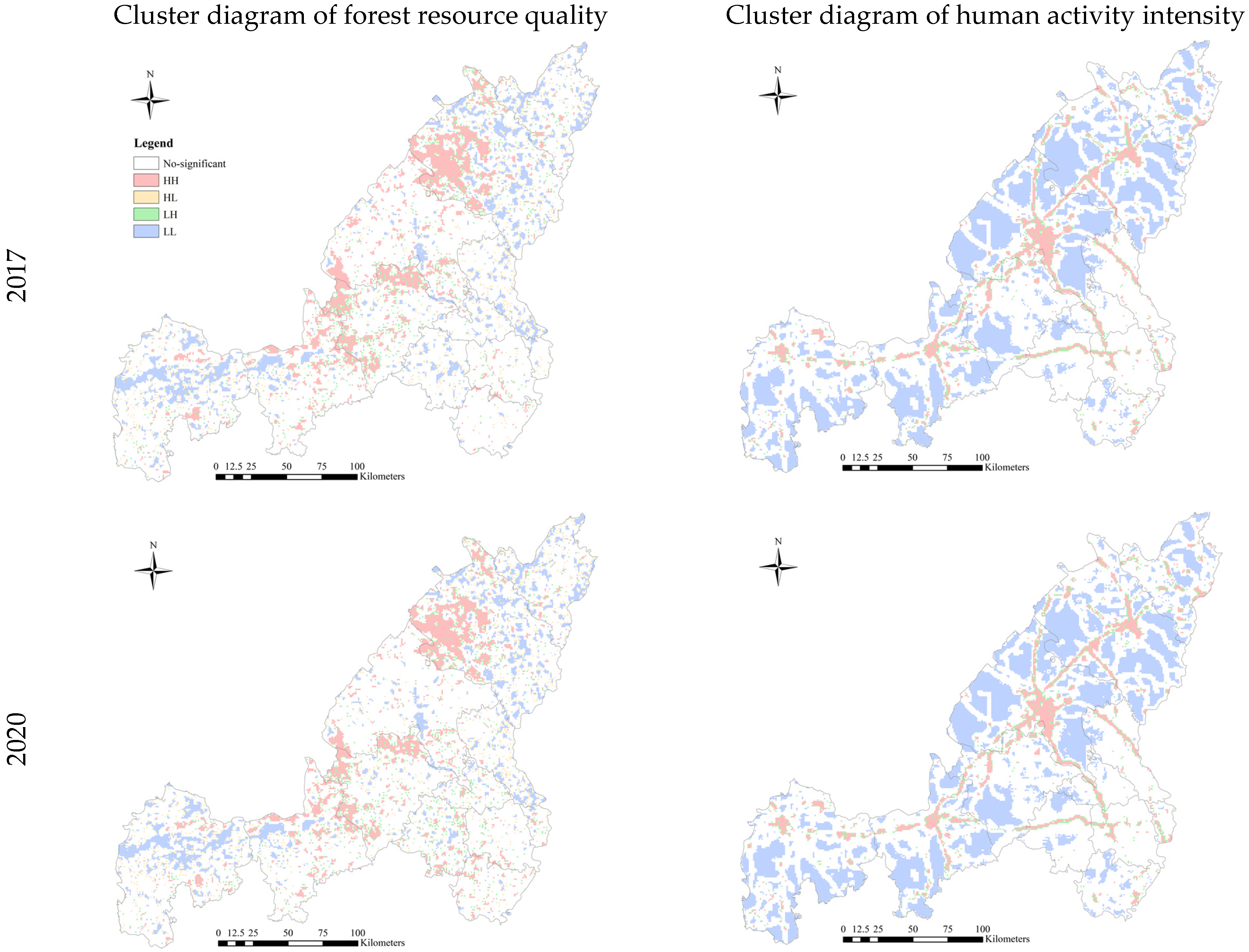
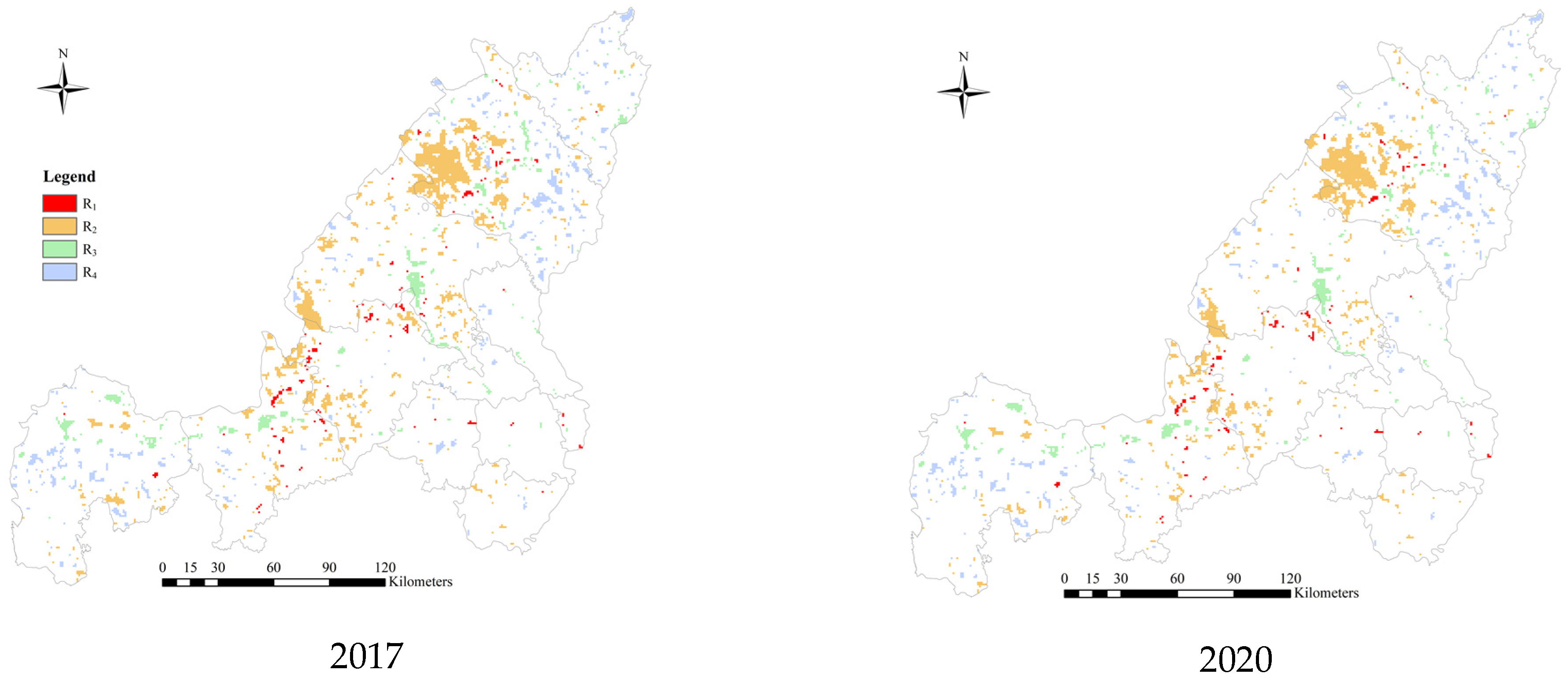
| Indicator | Weight | Assigned Value | ||||
|---|---|---|---|---|---|---|
| 1 | 2 | 3 | 4 | 5 | ||
| Volume per unit area | 0.4529 | Directly standardized by Formula (1) | ||||
| Quality grade of forest land | 0.0949 | V | IV | III | II | I |
| Age group | 0.0968 | Other | Young forest | Half-mature forest | Near-mature forest; overmature forest | Mature forest |
| Origin | 0.1281 | Other | — | Planted forest | — | Natural forest |
| Soil layer thickness | 0.1112 | Directly standardized by Formula (1) | ||||
| Soil type | 0.1015 | Saline stony soil | Acidic stony soil; neutral stony soil; calcareous stony soil; acidic coarse bone soil | White pulped brown coniferous forest soil | — | Yellow cinnamon soil; white pulped yellowish-brown soil |
| Slope | 0.0006 | Directly standardized by Formula (1) | ||||
| Aspect | 0.0140 | South | Southeast; southwest | East; west; flat ground | Northeast; northwest | North |
| Index | Weight | Method of Calculation |
|---|---|---|
| Road density | 0.2389 | Length of road/area (m/km2) |
| Percentage of impervious surface area | 0.2499 | Impervious surface area/area (%) |
| Population density | 0.5112 | Number of people/area (people/km2) |
| Forest Resource Quality | Human Activity Intensity | |||||
|---|---|---|---|---|---|---|
| Global Moran’s I | p | Z | Global Moran’s I | p | Z | |
| 2017 | 0.2124 | <0.01 | 86.08 | 0.5083 | <0.01 | 206.11 |
| 2020 | 0.1972 | <0.01 | 79.96 | 0.5103 | <0.01 | 206.94 |
Disclaimer/Publisher’s Note: The statements, opinions and data contained in all publications are solely those of the individual author(s) and contributor(s) and not of MDPI and/or the editor(s). MDPI and/or the editor(s) disclaim responsibility for any injury to people or property resulting from any ideas, methods, instructions or products referred to in the content. |
© 2023 by the authors. Licensee MDPI, Basel, Switzerland. This article is an open access article distributed under the terms and conditions of the Creative Commons Attribution (CC BY) license (https://creativecommons.org/licenses/by/4.0/).
Share and Cite
Song, C.; Yu, Q.; Jin, K. Forest Resource Quality and Human Activity Intensity Change and Spatial Autocorrelation Analysis in Yulin City, China. Forests 2023, 14, 1929. https://doi.org/10.3390/f14101929
Song C, Yu Q, Jin K. Forest Resource Quality and Human Activity Intensity Change and Spatial Autocorrelation Analysis in Yulin City, China. Forests. 2023; 14(10):1929. https://doi.org/10.3390/f14101929
Chicago/Turabian StyleSong, Chao, Qiyin Yu, and Kun Jin. 2023. "Forest Resource Quality and Human Activity Intensity Change and Spatial Autocorrelation Analysis in Yulin City, China" Forests 14, no. 10: 1929. https://doi.org/10.3390/f14101929
APA StyleSong, C., Yu, Q., & Jin, K. (2023). Forest Resource Quality and Human Activity Intensity Change and Spatial Autocorrelation Analysis in Yulin City, China. Forests, 14(10), 1929. https://doi.org/10.3390/f14101929





